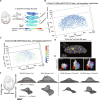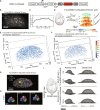A fibronectin gradient remodels mixed-phase mesoderm
- PMID: 39028807
- PMCID: PMC11259159
- DOI: 10.1126/sciadv.adl6366
A fibronectin gradient remodels mixed-phase mesoderm
Abstract
Physical processes ultimately shape tissue during development. Two emerging proposals are that cells migrate toward stiffer tissue (durotaxis) and that the extent of cell rearrangements reflects tissue phase, but it is unclear whether and how these concepts are related. Here, we identify fibronectin-dependent tissue stiffness as a control variable that underlies and unifies these phenomena in vivo. In murine limb bud mesoderm, cells are either caged, move directionally, or intercalate as a function of their location along a stiffness gradient. A modified Landau phase equation that incorporates tissue stiffness accurately predicts cell diffusivity upon loss or gain of fibronectin. Fibronectin is regulated by WNT5A-YAP feedback that controls cell movements, tissue shape, and skeletal pattern. The results identify a key determinant of phase transition and show how fibronectin-dependent directional cell movement emerges in a mixed-phase environment in vivo.
Figures





References
-
- Tao H., Zhu M., Lau K., Whitley O. K. W., Samani M., Xiao X., Chen X. X., Hahn N. A., Liu W., Valencia M., Wu M., Wang X., Fenelon K. D., Pasiliao C. C., Hu D., Wu J., Spring S., Ferguson J., Karuna E. P., Henkelman R. M., Dunn A., Huang H., Ho H. Y. H., Atit R., Goyal S., Sun Y., Hopyan S., Oscillatory cortical forces promote three dimensional cell intercalations that shape the murine mandibular arch. Nat. Commun. 10, 1703 (2019). - PMC - PubMed
Publication types
MeSH terms
Substances
LinkOut - more resources
Full Text Sources
Molecular Biology Databases

